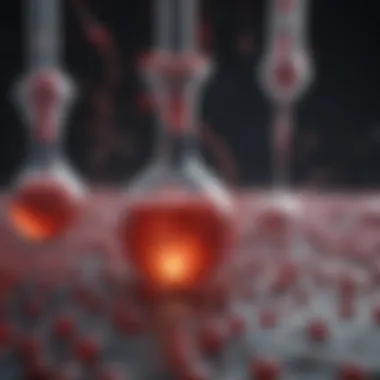Understanding Coagulated Blood: Mechanisms and Significance


Intro
Coagulated blood is a critical subject in both physiology and medicine. Understanding the mechanisms of blood coagulation provides insight into various health conditions. This overview seeks to clarify how blood changes from a liquid to a solid state. Recognizing these changes helps in diagnosing and managing coagulation disorders.
Overview of Research Topic
Brief Background and Context
Blood coagulation is essential for hemostasis. Hemostasis is the process that prevents excessive bleeding when injuries occur. The transition from liquid blood to a solid state is orchestrated by complex biochemical processes. These processes involve platelets and various proteins known as clotting factors.
In normal circumstances, when a blood vessel is injured, the body activates a series of responses. These include blood vessel constriction, platelet activation, and the coagulation cascade. Each step is vital; if any step fails, it may lead to significant medical conditions, such as hemophilia, thrombosis, or other bleeding disorders.
Importance in Current Scientific Landscape
The study of coagulated blood intersects various medical fields. It is significant in surgery, trauma care, and the treatment of chronic diseases. Recent advancements in understanding coagulation disorders offer insights into novel therapies. Innovative treatments have emerged that enhance patient outcomes in several clinical settings.
Methodology
Research Design and Approach
This article utilizes a comprehensive literature review approach. It explores existing studies and recent developments in hemostasis and coagulation disorders. By synthesizing information from diverse sources, the article aims to provide a detailed understanding of coagulated blood.
Data Collection Techniques
Data for this article has been collected from peer-reviewed journal articles, clinical studies, and authoritative medical texts. The research spans various disciplines, including hematology, biochemistry, and clinical medicine. This multi-faceted approach ensures a well-rounded perspective on coagulated blood.
Understanding coagulated blood is not merely an academic exercise. It has real-world implications for patient care and treatment strategies.
Foreword to Coagulated Blood
Coagulated blood is an essential component in the field of medicine as it plays a vital role in hemostasis, wound healing, and overall bodily function. Understanding coagulated blood is crucial not only for medical professionals but also for researchers and students aiming to acquire a deeper knowledge of the physiological and biochemical processes involved. This section will explore the definition of coagulated blood and its importance in human health, as well as provide a basic understanding of blood structure.
Definition and Importance
Coagulated blood refers to blood that has undergone the process of coagulation, a complex series of events that transforms liquid blood into a semi-solid gel. This transformation is crucial for stopping bleeding and initiating tissue repair when blood vessels are injured. Without coagulation, even minor wounds could result in excessive blood loss, which can be life-threatening.
The importance of studying coagulated blood lies in its implications for health and disease. For instance, an understanding of coagulation can help medical professionals identify and manage various conditions such as thrombosis and bleeding disorders. These conditions can have severe outcomes if not addressed appropriately. Thus, having a thorough comprehension of coagulated blood facilitates better clinical decision-making and patient care.
Basic Structure of Blood
Blood is a specialized bodily fluid consisting of various components that serve specific functions. It can be classified into two main categories: formed elements and plasma.
- Formed Elements: These include red blood cells, white blood cells, and platelets. Red blood cells are responsible for transporting oxygen, while white blood cells are key players in the immune response. Platelets are essential for the clotting process.
- Plasma: This is the liquid component of blood, comprising about 55% of its total volume. Plasma is primarily made up of water, but it also contains proteins, electrolytes, nutrients, and waste products. The protein content, including clotting factors, plays a significant role in the coagulation process.
The Hemostasis Process
The process of hemostasis is crucial in understanding how blood clots form and function within the body. Hemostasis is not only a natural response to injury but also involves complex mechanisms essential for maintaining vascular integrity. Understanding this process holds implications for various fields, from surgery to hematology, as it lays the foundation for managing bleeding and thrombotic disorders. Knowledge about hemostasis enables healthcare professionals to intervene effectively when abnormal conditions arise, such as excessive bleeding or clot formation, thereby ensuring optimal patient outcomes.
Stages of Hemostasis
Hemostasis can be divided into three main stages: primary hemostasis, secondary hemostasis, and fibrinolysis. Each of these stages plays a significant role in the overall blood clotting process and must be carefully orchestrated to prevent either excessive bleeding or unwanted thrombosis.
Primary Hemostasis
Primary hemostasis is the initial response to blood vessel injury, primarily involving the activation of platelets. When damage occurs, platelets adhere to exposed collagen in the vessel wall, forming a temporary plug to seal the wound. One key characteristic of primary hemostasis is its rapid response; the body reacts quickly to immediate threats. This is beneficial for ensuring that bleeding does not become life-threatening. However, a downside is that if not properly regulated, primary hemostasis can contribute to excessive clotting, which may lead to complications. Its unique feature lies in the intricate interactions between platelets and the vascular endothelium, which serve to halt bleeding effectively.
Secondary Hemostasis
Secondary hemostasis follows primary hemostasis and involves a cascade of clotting factors that further stabilize the platelet plug. This process is essential for forming a strong fibrin mesh that solidifies the clot. A key characteristic of secondary hemostasis is its reliance on a complex series of reactions involving pro-coagulant and anti-coagulant factors. Its structured nature allows for a more controlled and robust response to vascular injury, which increases effectiveness. However, an overactive secondary hemostasis can lead to pathological clots, detrimental to circulation. The mechanism of this stage highlights the necessity for precise interaction between factors to ensure effective clot stabilization.
Fibrinolysis
Fibrinolysis is the final stage of hemostasis, where the removal of the clot occurs after repair of the blood vessel is established. This process is critical because it prevents excessive accumulation of fibrin and restores normal blood flow. Its key characteristic is the breakdown of fibrin, primarily initiated by plasminogen activation. This aspect is beneficial as it allows the system to return to balance after healing. The unique feature of fibrinolysis is its regulatory mechanisms, which ensure that clot degradation happens appropriately. Disadvantages arise when fibrinolysis is either inadequate or excessive, leading to bleeding risks or unresolved clots, respectively. Understanding this balance is essential for treating various coagulation disorders.
Cellular Components Involved
The cellular players in hemostasis are central to achieving effective response during vascular injury. The significant components that work together include platelets, coagulation factors, and endothelial cells. Each of these cellular components contributes distinctively to the hemostatic process.
Platelets


Platelets are the primary cellular component involved in hemostasis. They are critical for initiating the clotting process and forming the initial plug at the site of injury. A key characteristic of platelets is their ability to undergo shape change upon activation, allowing for better adhesion and aggregation. This is particularly relevant in superficial bleeding events. However, an excess of activated platelets can lead to thrombus formation, creating complications. Their unique feature is that they also release signaling molecules that attract more platelets, amplifying the response, which is crucial but can become a disadvantage in some contexts.
Coagulation Factors
Coagulation factors are proteins that play essential roles in the blood coagulation cascade. These factors work in a sequence to ensure that clotting is effective and efficient. One key aspect of coagulation factors is their ability to activate each other in a cascade. This amplifies the response to vascular injury, helping to swiftly form stable clots. The disadvantage, though, lies in conditions where certain factors are deficient or overactive, which can disrupt hemostasis and lead to either bleeding issues or thrombotic complications. Their unique feature includes the localization of these factors within the system, highlighting their importance in both pro-coagulation and anticoagulation processes.
Endothelial Cells
Endothelial cells line the blood vessels and have a significant impact on hemostasis. They are crucial in maintaining balance between bleeding and clotting. One key characteristic of endothelial cells is their ability to release factors that either promote or inhibit clotting, such as nitric oxide and prostacyclin. This makes them vital operators in the hemostatic equilibrium. However, endothelial dysfunction can lead to increased clotting risks or excessive bleeding. The unique ability of these cells to sense and respond to mechanical and chemical stresses underscores their importance in hemostatic regulation.
Biochemical Mechanisms of Coagulation
The biochemical mechanisms of coagulation are crucial for maintaining hemostasis and preventing excessive bleeding. Understanding these mechanisms is essential because they involve a complex network of proteins, enzymes, and cells that regulate blood clotting. This section will explore the role of coagulation factors, as well as signal transduction processes in coagulation, providing insight into how these elements contribute to the overall function of blood coagulation.
Role of Coagulation Factors
Intrinsic Pathway
The intrinsic pathway of coagulation is primarily responsible for amplifying the clotting response once it has initiated. This pathway is characterized by its reliance on factors present within the blood, specifically activated clotting factors. The key characteristic of this pathway is its ability to activate itself through a cascade reaction.
One of the reasons the intrinsic pathway is a significant focus of this article is its role in conditions where damage to blood vessels occurs, resulting in exposure of collagen and other factors. Its unique feature lies in its capacity to respond to injuries without external triggers, providing a robust response in various clinical scenarios. However, this pathway can be slower in activating compared to its counterpart, the extrinsic pathway.
Extrinsic Pathway
The extrinsic pathway is the initial response to vascular injury, triggered by tissue factor (TF) released from damaged endothelial cells. This pathway is noted for its rapid onset; it is beneficial in situations requiring immediate clot formation. The key characteristic that highlights its importance is its dependence on an external factor, tissue factor, to kickstart the clotting cascade.
The unique feature of the extrinsic pathway is its direct and swift activation of prothrombin to thrombin. While highly effective for prompt responses to injury, reliance on external factors might pose some disadvantages in controlling excessive clotting risks.
Common Pathway
The common pathway integrates signals from both the intrinsic and extrinsic pathways, ultimately leading to the formation of a fibrin clot. It begins with the conversion of prothrombin to thrombin and is characterized by its crucial role in the final stages of coagulation. This pathway unites elements from both preceding pathways, hence highlighting its importance in this article.
A significant advantage of the common pathway is its efficiency in producing a stable clot. However, its reliance on the timely activation of earlier stages means that disruptions can affect the overall process.
Signal Transduction in Coagulation
Signal transduction is vital in coordinating the coagulation response. It involves the communication between cells that leads to activation of coagulation factors and ultimately the formation of a clot.
Receptor Activation
Receptor activation occurs when specific receptors on platelets and endothelial cells bind to particular ligands, such as thrombin, which leads to cellular responses necessary for effective coagulation. This aspect is highlighted in this article due to its critical role in initiating the clotting process at the site of injury.
A unique feature of receptor activation is its ability to trigger a series of downstream events that enhance platelet activation and aggregation. The disadvantage may arise from potential overstimulation, leading to thrombotic complications in certain conditions.
Calcium Ions' Importance
Calcium ions play a significant role in coagulation by acting as secondary messengers in the activation of various clotting factors. Their importance in this article relates to their necessity for effective clot formation, as many coagulation pathways require calcium for activation.
The unique feature of calcium ions in coagulation is their widespread influence across virtually all stages. However, variations in calcium levels can impact coagulation efficiency, leading to disorders if not regulated properly.
Cascade Amplification
Cascade amplification refers to the exponential increase in active clotting factors during the coagulation process. This aspect is beneficial as it ensures a rapid and effective response to vascular injury. It amplifies signals resulting from initial receptor activations, leading to a significant formation of thrombin and fibrin.
The unique feature of cascade amplification is its ability to generate a substantial response with minimal initial input. Nonetheless, the downside is potential uncontrollable clotting if the cascade is not properly regulated.
The intricate balance of coagulation mechanisms underscores the complexity of maintaining hemostasis and highlights the significance of understanding these processes in clinical settings.
Pathophysiology of Coagulation Disorders
Coagulation disorders are significant for understanding how blood clotting functions and how impediments can result in serious medical conditions. Pathophysiology highlights how these disorders develop and their effects on hemostasis. Both thrombosis and bleeding disorders can lead to various complications, underscoring the need for early detection and appropriate management.
Thrombosis
Thrombosis is the condition in which blood clots form inappropriately. These clots may occur within blood vessels, obstructing normal blood flow. There are different types of thrombosis including venous thromboembolism and arterial thrombosis. Each type presents unique challenges in clinical practice.
Types of Thrombosis
There are several types of thrombosis, and understanding them is critical for diagnosis and treatment. The key characteristic of thrombosis is its potential to cause significant health issues if not addressed timely. For example, deep vein thrombosis (DVT) can lead to pulmonary embolism, which is life-threatening.


- Venous Thromboembolism (VTE): Occurs in veins, often in the legs, which can lead to embolism.
- Arterial Thrombosis: Typically occurs in arteries, can cause heart attacks or strokes.
The unique feature of thrombosis is its dual nature; it can be both protective by preventing blood loss and dangerous by causing unintended blockage.
Risk Factors
Risk factors for thrombosis provide insights into who may develop these disorders. Key characteristics include genetic predispositions and acquired factors. Identifying these risks can shape preventative strategies.
Some common risk factors include:
- Age: Older individuals are at higher risk.
- Obesity: Higher body weight increases pressure on veins.
- Immobilization: Lengthy periods of inactivity can promote clot formation.
Understanding risk factors can aid in developing effective management plans for patients.
Clinical Consequences
The clinical consequences of thrombosis are profound. Thrombosis can lead to severe events such as myocardial infarction or stroke. This emphasizes the importance of timely intervention and awareness among medical professionals.
Unique features include:
- Acute Events: Thrombosis can manifest suddenly with severe consequences.
- Chronic Impact: Patients may face long-term complications, including post-thrombotic syndrome.
Bleeding Disorders
Bleeding disorders are another aspect of coagulation pathophysiology. These conditions impair the body’s ability to stop bleeding. Understanding these disorders is essential for effective patient management and treatment.
Hemophilia
Hemophilia is a genetic bleeding disorder resulting from insufficient clotting factors. This disorder primarily affects males and presents a unique challenge for treatment. The hallmark of hemophilia is the predisposition to prolonged bleeding, even from minor injuries.
- Type A: Due to deficiency of factor VIII.
- Type B: Caused by a deficiency in factor IX.
The treatment usually requires factor replacement therapy.
Von Willebrand Disease
Von Willebrand Disease is the most common inherited bleeding disorder. It is characterized by a deficiency or dysfunction of von Willebrand factor, which is crucial for platelet adhesion. This can result in easy bruising and heavy menstrual bleeding.
Key characteristics include:
- Variable Severity: Symptoms vary widely among individuals.
- Common Symptoms: Easy bruising and frequent nosebleeds.
Acquired Disorders
Acquired bleeding disorders develop in response to various factors including medications and liver disease. Common causes include the use of anticoagulants such as warfarin and conditions like liver failure.
Some unique features are:
- Association with Medications: Many patients may not be aware that their medication can increase bleeding risk.
- Lifestyle Factors: Nutrition and lifestyle can also influence clotting.
These points illustrate that understanding the pathophysiology of coagulation disorders is essential for effective risk management and treatment in clinical settings.
Clinical Relevance of Coagulated Blood
Coagulated blood is not just a biological phenomenon; it plays a critical role in various medical contexts. Understanding the clinical relevance of coagulated blood helps healthcare professionals in diagnosing and managing numerous conditions. The mechanisms behind coagulation impact areas such as surgery, trauma care, and chronic disease management. Knowledge in this area is vital for effective patient care. This section will expound upon the diagnostic and management techniques related to coagulated blood, emphasizing their significance.
Diagnostic Approaches
Coagulation Tests
Coagulation tests are essential tools that allow clinicians to assess the blood's ability to clot. These tests measure the time it takes for blood to coagulate, helping to identify abnormalities in the coagulation process. One key characteristic of coagulation tests is their ability to guide treatment decisions. They are a favored choice in clinical practice due to their reliability and straightforward execution. The major advantage of coagulation tests, such as Prothrombin Time (PT) and Activated Partial Thromboplastin Time (aPTT), is their role in monitoring anticoagulant therapy.
However, one disadvantage is the variability in test results based on a patient's unique physiology. This variability can sometimes lead to misinterpretations, necessitating a careful clinical correlation.
Laboratory Assessment
Laboratory assessment encompasses various methods used to evaluate coagulated blood and its properties. This assessment often includes platelet counts and levels of coagulation factors. A critical benefit of laboratory assessment is its comprehensive nature. With detailed analysis, clinicians can pinpoint the root cause of coagulation disorders.
One unique feature of laboratory assessments is the use of specialized assays, which provide greater specificity. However, a limitation may be the time-sensitive nature of results; some tests may require a longer turnaround time, potentially delaying diagnosis and treatment.


Imaging Techniques
Imaging techniques, such as ultrasound and CT scans, are integral in evaluating conditions related to coagulated blood. These tools help visualize areas where clots may form or where bleeding occurs. A prominent advantage of imaging techniques is their non-invasive nature, offering real-time insights into a patient’s condition.
One unique aspect is the capability to assess complications due to coagulation issues, like deep vein thrombosis. Nevertheless, the disadvantage lies in their inability to provide direct measures of coagulation status, often requiring correlation with laboratory findings to draw full conclusions.
Management of Coagulation Disorders
Anticoagulant Therapy
Anticoagulant therapy is a cornerstone in managing patients at risk for thrombotic events. These medications prevent blood clots, proving critical in conditions like atrial fibrillation and after certain surgeries. The primary characteristic of anticoagulant therapy is its ability to reduce the risk of stroke and other complications. This makes it a popular choice in clinical settings.
However, one unique feature is the need for careful monitoring of anticoagulation levels to prevent excessive bleeding, which poses a significant risk. The challenge is balancing efficacy and safety, necessitating a tailored approach for each patient.
Platelet Function Modulators
Platelet function modulators play a crucial role in managing patients with coagulation disorders. They alter the activity of platelets, which are vital for blood clotting. The main benefit of these modulators is their ability to enhance or inhibit platelet activity depending on clinical needs. For instance, they are important in preventing arterial thrombi in cases like coronary artery disease.
One unique aspect is their use in combination with other therapies, maximizing treatment effectiveness. A downside, however, is the potential for side effects, which may necessitate careful patient selection.
Transfusion Practices
Transfusion practices are vital in treating severe coagulation disorders or excessive bleeding. They involve the administration of blood products to restore physiological function. A key characteristic of transfusion practices is their ability to rapidly stabilize a patient's condition.
One unique feature is the advancement in blood matching and screening processes, which enhances patient safety. On the other hand, the disadvantages include the risk of transfusion reactions, which can be serious. Health professionals must weigh risks against benefits meticulously.
Understanding the clinical relevance of coagulated blood is essential for effective patient care and treatment strategies.
The knowledge gained from diagnosing and managing coagulation-related conditions directly impacts patient outcomes. As research continues, the importance of coagulated blood will only grow, making ongoing education in this field imperative for healthcare professionals.
Recent Advances in Coagulation Research
Recent advances in coagulation research are critical for understanding blood coagulation's complexity and evolving methods of treatment for related disorders. Continuing studies explore new anticoagulants and genetic factors contributing to coagulation. These insights help improve patient outcomes and refine treatment strategies, acknowledging the nuances of individual health conditions.
Novel Anticoagulants
Novel anticoagulants represent a significant step forward in pharmacotherapy for coagulation disorders. Unlike traditional anticoagulants, such as warfarin, newer agents do not require frequent monitoring and have more predictable effects. Drugs such as apixaban, rivaroxaban, and dabigatran have emerged as popular choices. They target specific pathways and provide effective thrombosis prevention.
The benefits of these agents include:
- Ease of Use: Patients often find them easier to manage in comparison to older medications.
- Fewer Drug Interactions: These newer drugs typically have limited interactions with other medications.
- Immediate Effects: Unlike some traditional anticoagulants, these drugs provide quicker onset of action.
Despite these advantages, there are still considerations. The need for patient education is paramount. Understanding the dosing schedule and potential effects on bleeding risks remains essential for safe use.
Genetic Insights
Genetic insights into coagulation disorders have enhanced our understanding of individual variability in response to treatment. Research has identified various genetic markers that influence coagulation factor levels and platelet function. For instance, polymorphisms in genes related to factors like prothrombin and factor V can predispose individuals to thrombosis.
These findings support personalized medicine approaches. Clinicians can tailor treatments based on genetic profiles, optimizing efficacy and minimizing risks. Furthermore, advancements in genomics enable the identification of hereditary conditions like thrombophilia. This knowledge aids in both diagnosis and long-term management.
Future Directions
Looking ahead, research in coagulation is poised to expand. Future directions may include:
- Enhanced Genetic Testing: Identifying more genetic variants that affect coagulation.
- Development of Antithrombotic Agents: Innovations in drugs targeting specific molecular pathways for better outcomes.
- Biomarker Discovery: Identifying biomarkers that can predict complications related to coagulation disorders.
The focus on ongoing clinical trials will also be crucial. They will help assess the safety and effectiveness of new treatments in diverse populations. Understanding the implications of these advancements is vital for improving clinical practices and enhancing patient care.
Ongoing research in coagulation is not merely academic but profoundly impacts therapeutic strategies and patient outcomes.
Ending
The conclusion of this article serves as a pivotal section that synthesizes the extensive information presented throughout. It underscores the critical role that coagulated blood plays in maintaining hemostatic balance and its various implications in clinical settings. Understanding the mechanisms of coagulation is not just an academic exercise. It has direct relevance in diagnosing and treating a range of disorders. The dynamic nature of hemostasis means that ongoing research and clinical studies are essential.
Summary of Key Points
In summary, this article encapsulates several key points regarding coagulated blood:
- Hemostasis is a multi-stage process that includes primary hemostasis, secondary hemostasis, and fibrinolysis.
- Cellular components like platelets, coagulation factors, and endothelial cells play significant roles in the coagulation process.
- Various coagulation disorders, such as thrombosis and bleeding disorders, showcase the complexity of this biological process.
- Advances in diagnostic and therapeutic approaches have a profound impact on managing coagulation disorders. This includes the usage of novel anticoagulants and genetic insights into coagulation.
By addressing each of these aspects, the article provides a holistic view of coagulated blood, articulating its complexity and the importance of understanding it in both health and disease.
Implications for Future Research
Looking ahead, several areas warrant further investigation to enhance our understanding of coagulated blood and its clinical significance:
- Exploration of Genetic Factors: Future studies could focus on the genetic basis of coagulation disorders. This could lead to personalized therapies for affected individuals.
- Development of Better Anticoagulants: Research into more effective and safer anticoagulant therapies is necessary. This can help mitigate the risk of thromboembolic events.
- Novel Diagnostics Techniques: Innovations in imaging techniques and laboratory assessments can improve the diagnosis of coagulation disorders.



